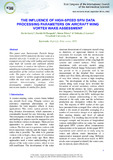JavaScript is disabled for your browser. Some features of this site may not work without it.
| dc.contributor.author | Garry, Kevin | |
| dc.contributor.author | Di Pasquale, Davide | |
| dc.contributor.author | Prince, Simon A. | |
| dc.contributor.author | Lawson, Nicholas J. | |
| dc.date.accessioned | 2019-03-13T14:42:25Z | |
| dc.date.available | 2019-03-13T14:42:25Z | |
| dc.date.issued | 2018-12-31 | |
| dc.identifier.citation | Garry K, Di Pasquale D, Prince S, Lawson N. (2018) The influence of high-speed SPIV data processing parameters on aircraft wing vortex wake assessment. 31st Congress of the International Council of the Aeronautical Sciences, 9-14 September 2018, Belo Horizonte, Brazil | en_UK |
| dc.identifier.isbn | 978-3-932182-88-4 | |
| dc.identifier.uri | https://dspace.lib.cranfield.ac.uk/handle/1826/13985 | |
| dc.identifier.uri | https://www.icas.org/ICAS_ARCHIVE/ICAS2018/data/preview/ICAS2018_0297.htm | |
| dc.description | © The Author. | |
| dc.description.abstract | SPIV is a powerful tool to assess aircraft wing vortex wakes. Current optical systems enable velocity vector measurements at sample rates of 10Hz. This facilitates detailed assessment of flows containing multiple, potentially unsteady, vortices. SPIV data from the wake of a high-lift wing is used to investigate data sampling strategies on the magnitude of vortex trajectory and strength. | en_UK |
| dc.language.iso | en | en_UK |
| dc.publisher | ICAS | en_UK |
| dc.rights | Attribution 4.0 International | |
| dc.rights | © The Author. | |
| dc.rights.uri | http://creativecommons.org/licenses/by/4.0/ | |
| dc.subject | High-Lift | en_UK |
| dc.subject | Wake vortex | en_UK |
| dc.subject | SPIV | en_UK |
| dc.title | The influence of high-speed SPIV data processing parameters on aircraft wing vortex wake assessment | en_UK |
| dc.type | Conference paper | en_UK |
Files in this item
The following license files are associated with this item:
This item appears in the following Collection(s)
-
Staff publications (SATM) [4360]

